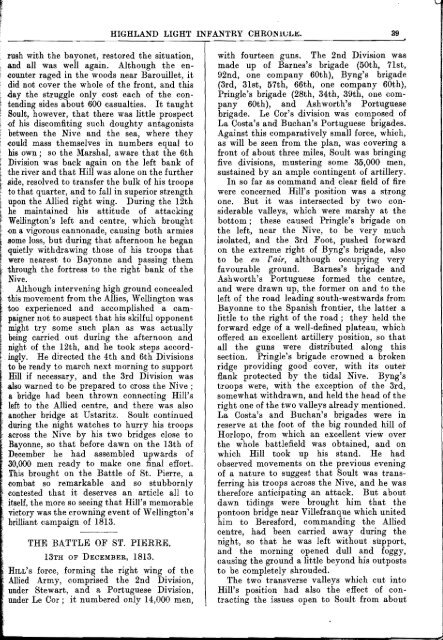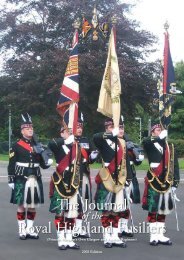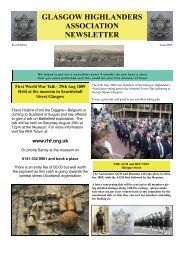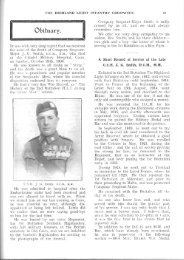HLI Chronicle 1914 - The Royal Highland Fusiliers
HLI Chronicle 1914 - The Royal Highland Fusiliers
HLI Chronicle 1914 - The Royal Highland Fusiliers
- No tags were found...
Create successful ePaper yourself
Turn your PDF publications into a flip-book with our unique Google optimized e-Paper software.
HIGHLAND LIGHT INFANTRY CHRO.NllJLl!:. 39rush with the bayonet, restored the situation,and all was well again. Although the encounterraged in the woods near Barouillet, itdid not cover the whole of the front, and this.day the struggle only cost each of the contendingsides about 600 casualties. It taughtSoult, however, that there was little prospect{If his discomfiting such doughty antagonistsbetween the Nive and the sea, where theycould mass themselves in numbers equal tohis own; so the Marshal, aware that the 6thDivision was back again on the left bank ofthe river and that Hill was alone on the furtherBide, resolved to transfer the bulk of his troopsto that quarter, and to fall in superior strengthupon the Allied right wing. During the 12thhe maintained his attitude of attackingWellington's left and centre, which brought{In a vigorous cannonade, causing both armiesBome loss, but during that afternoon he beganquietly withdrawing those of his troops thatwere nearest to Bayonne and passing themthrough the fortress to the right bank of theNive.Although intervening high ground concealedthis movement from the Allies, Wellington wastoo experienced and accomplished a campaignernot to suspect that his skilful opponentmight try some such plan as was actuallybeing carried out during the afternoon andnight of the 12th, and he took steps accord.ingly. He directed the 4th and 6th Divisionsto be ready to march next morning to supportHill if necessary, and the 3rd Division wasalso warned to be prepared to cross the Nive ;a bridge had been thrown connecting Hill'sleft to the Allied centre, and there was alsoanother bridge at Ustaritz. Soult continuedduring the night watches to hurry his troopsacross the Nive by his two bridges close toBayonne, so that before dawn on the 13th ofDecember he had assembled upwards of30,000 men ready to make one final effort.This brought on the Battle of St. Pierre, acombat so remarkable and so stubbornlycontested that it deserves an article all toitself, the more so seeing that Hill's memorablevictory was the crowning event of Wellington'sbrilliant campaign of 1813.THE BATTLE OF ST. PIERRE. 13TH OF DECEMBER, 1813. HILL'S force, forming the right wing of the Allied Army, comprised the 2nd Division, under Stewart, and a Portuguese Division, under Le Cor; it numbered only 14,000 men, with fourteen guns. <strong>The</strong> 2nd Division wasmade up of Barnes's brigade (50th, 7lst,92nd, one company 60th), Byng's brigade(3rd, 31st, 57th, 66th, one company 60th),Pringle's brigade (28th, 34th, 39th, one company60th), and Ashworth's Portuguesebrigade. Le Cor's division wa's composed ofLa Costa's and Buchan's Portuguese brigades.Against this comparatively small force, which,as will be seen from the plan, was covering afront of about three miles, Soult was bringingfive divisions, mustering some 35,000 men,sustained by an ample contingent of artillery.In so far as command and clear field of firewere concerned Hill's position was a strongone. But it was intersected by two considerablevalleys, which were marshy at thebottom; these caused Pringle's brigade onthe left, near the Nive, to be very muchisolated, and the 3rd Foot, pushed forwardon the extreme right of Byng's brigade, alsoto be en l'a-ir, although occupying veryfavourable ground. Barnes's brigade andAshworth's Portuguese formed the centre,and were drawn up, the former on and to theleft of the road leading south-westwards fromBayonne to the Spanish frontier, the latter alittle to the right of the road; they held theforward edge of a well-defined plateau, whichoffered an excellent artillery position, so thatall the guns were distributed along thissection. Pringle's brigade crowned a brokenridge providing good cover, with its outerflank protected by the tidal Nive. Byng'stroops were, with the exception of the 3rd,somewhat withdrawn, and held the head of theright one of the two valleys already mentioned.La Costa's and Buchan's brigades were inreserve at the foot of the big rounded hill ofHorlopo, from which an excellent view overthe whole battlefield was obtained, and onwhich Hill took up his stand. He hadobserved movements on the previous eveningof a nature to suggest that Soult was transferringhis troops across the Nive, and he wastherefore anticipating an attack. But aboutdawn tidings were brought him that thepontoon bridge near Villefranque which unitedhim to Beresford, commanding the Alliedcentre, had been carried away during thenight, so that he was left without support,and the morning opened dull and foggy,causing the ground a little beyond his outpoststo be completely shrouded.<strong>The</strong> two transverse valleys which cut intoHill's position had also the effect of contractingthe issues open to Soult from about
















